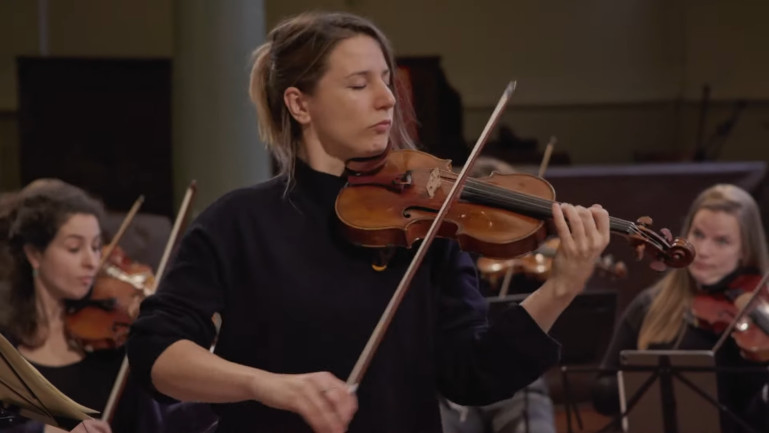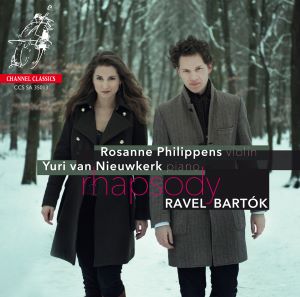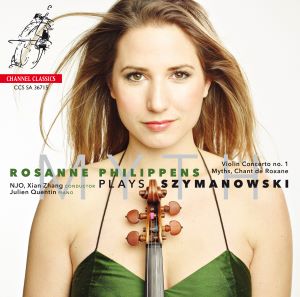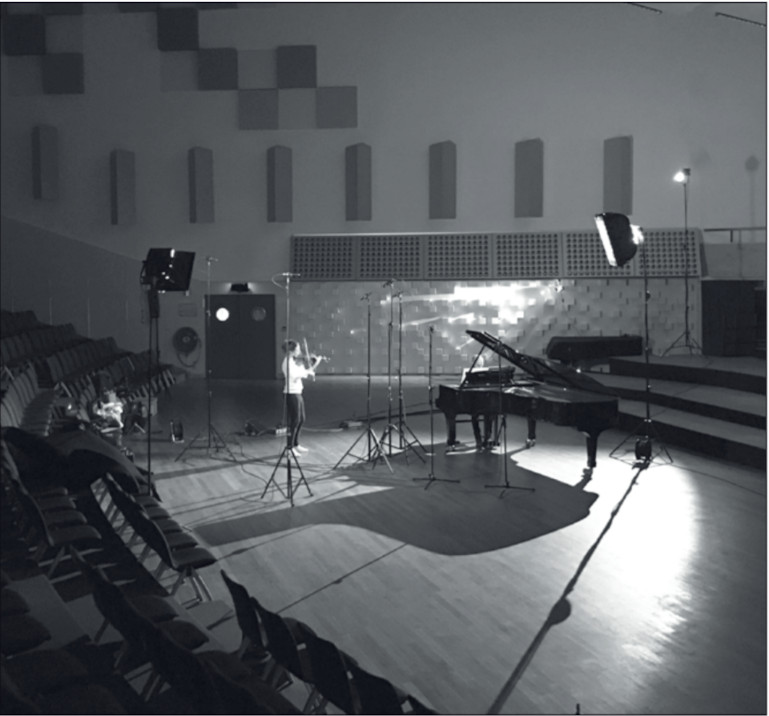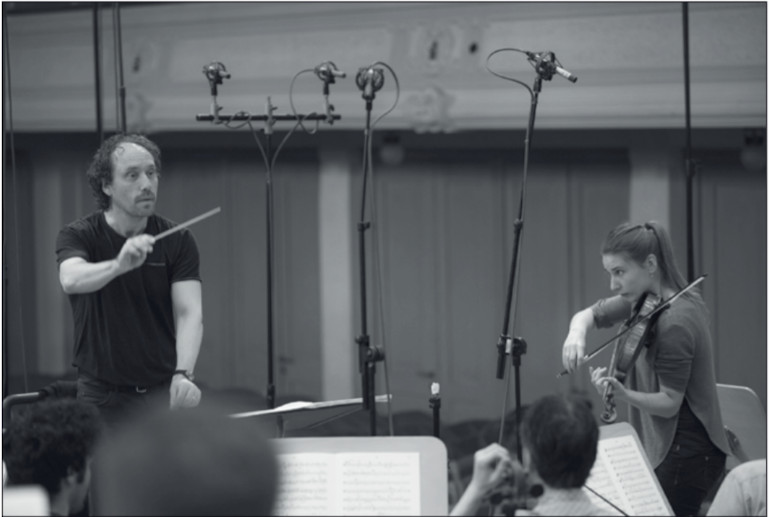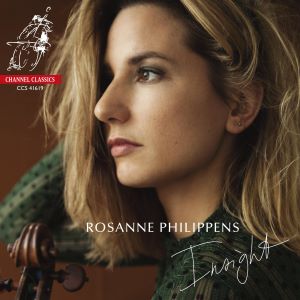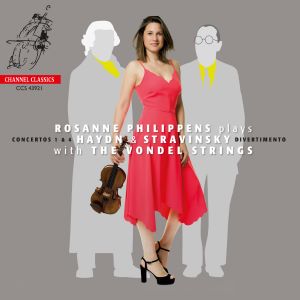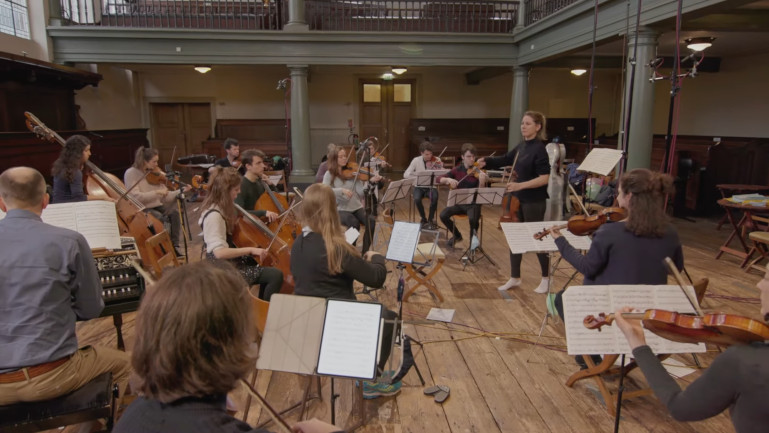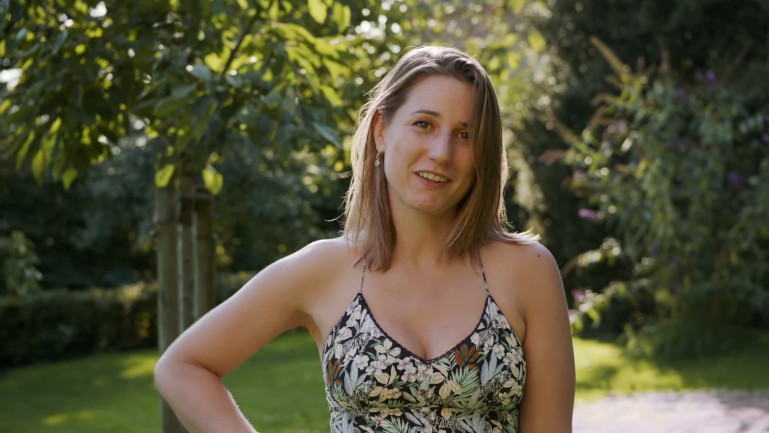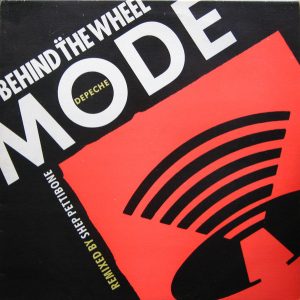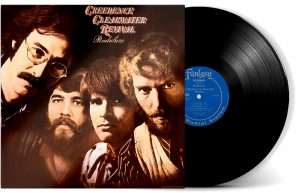I have been enjoying the performances of violinist Rosanne Philippens for several years, but have not yet written about her recordings. She is remarkable, a tremendous talent, and someone whose work I value very much. My music library is enriched by her performances, as am I each time I select one to hear. Let's take a look at some of her recordings…
Rosanne Philippens. Still from promo video for 2021 album Rosanne Philippens Plays Haydn & Stravinsky, discussed below.
- Rhapsody - Ravel and Bartok, Rosanne Philippens
- Myth: Rosanne Philippens Plays Szymanowski
- Dedications, Rosanne Philippens
- Rosanne Philippens plays Prokofiev
- Insight, Rosanne Philippens
- Rosanne Philippens plays Haydn and Stravinsky
- Conclusion
So why so long to write about one of her recordings? I have no excuse. I really should not have waited. Particularly for her most recent 2021 release with her ensemble, The Vondel Strings, which I'll talk about last. Let us start at the beginning, with her release in January 2014 of music by Ravel and Bartok.
Rhapsody - Ravel and Bartok, Rosanne Philippens violin, Yuri Van Nieuwkerk piano. Channel Classics 2012, released 2014 (DSD64) HERE
This is a first album that will rivet one's attention. Wrote The WholeNote at the time of release "The young Dutch violinist Rosanne Philippens is a new name to me, but if Rhapsody, her debut CD on Channel Classics (CCS SA 35013), is anything to go by, we'll all be hearing a lot more of her in the future."
And indeed we have over the years since. Recorded by Jared Sacks in November 2012, at Kleine Zaal Eindhoven, Philippens and Van Nieuwkerk take on some very challenging music—and deliver handsomely.
Ravel and Bartok may seem like an odd coupling, but it works. As Philippens and Van Nieuwkerk write in the accompanying booklet, when Ravel and Bartók wrote these works, "music styles from all corners of the world were blowing across the European continent, taking root as folk dances, blues rhythms and exotic melodies in the hearts of classically trained musicians... Bartok and Ravel show us how traditional craftsmanship can be combined with the sounds of other cultures...it is the catch in the voice and the raw expression which captivate us beyond the concert hall. All these elements are brought together in masterly fashion."
Ravel's Tzigane is given a straightforward but very solid performance, but the real Ravel gem here is the Violin Sonata No.2, which showcases Philippens' big, expansive tone. The performance partners are in perfect alignment.
The Bartok pieces capture just the right mix of spikiness and lyricism in the two Rhapsodies from 1928 and the Rumanian Folk Dances from 1915. Philippens has commented elsewhere that music is not all about perfectly rounded and polished notes—"sometimes a sharp edge produces the character one is looking for." And that is precisely what is needed and delivered in these works.
In later albums, Philippens simply gets better and better in her interpretation and in her communication of her music. Starting from such a high standard as this 2012 recording, it is hard to imagine, but this is what I hear as I re-listen through her recorded works with Channel Classics. Let's continue...
Myth: Rosanne Philippens Plays Szymanowski, with Julien Quentin, piano. Channel Classics 2014, released 2015 (DSD 64) HERE
Symanowski and Stravinsky—this violinist has moxie. And her selections could not be more appealing to this lover of music from the twentieth century.
Track 1 launches straight into a completely magical piece: Szymanowski's Violin Concerto No. 1 (1916). Ecstatic, sumptuous, intense, this first concerto set the stage for new conceptions of the concerto form. Often cited as the first modern violin concerto, it broke with convention of the period, rejecting traditional tonality and moving to shape a vocabulary at once primitive and avant-garde. Philippens then moves on to three other outstanding, and very challenging, works of Szymanowski: Chant de Roxane, Myths, and Nocturne and Tarantella.
Following the wild Tarantella, Philippens shifts gears with Stravinky's lyrically dancing Chanson Russe and then smoothly into the Berceuse from L'Oiseau de Feu (Firebird) ballet, the lullaby with which the Firebird sings the evil magician Kashchei to sleep. The album closes with the elated Scherzo, which in the fairytale ballet accompanies the dancing princesses while they play with golden apples.
That Philippens not only traverses these works, but does so with extreme grace and energy, seemingly effortlessly, is flatly breathtaking. She not only demonstrates an extraordinary degree of technical competence, she simply glows with a passion for the music and an infectious joy in the music making.
Do I like this recording? Oh, you bet I do. It's marvelous.
Dedications, Rosanne Philippens and Julien Quentin. Channel Classics 2016 (DSD 64) HERE
Violin playing for me is a combination of singing and speaking, not all notes need to be very round and polished, sometimes a sharp edge produces the character one is looking for. Rosanne Philippens
This comment by Philippens in her notes for the album describes nicely what I so much enjoy about her playing. She is extraordinarily sensitive to the nuances that bring music to life. Her playing is beautiful to my mind, but she accomplishes this by not avoiding the sharp edges where they are needed.
On Dedications, her third Channel Classics recording, Philippens again partners with pianist Julien Quentin in performing works by Fauré, Chausson, Kreisler, Saint-Saëns, and Ysaÿe. Philippens's love of Ysaÿe's Poème élégiaque, a piece dedicated to Gabriel Fauré, inspired her to create a program of music by composers who respected and honored each other. The connections Philippens describes in her liner notes I find interesting both historically and for appreciating musically what is happening in these works.
Apparently, Fauré often visited the famous singer Pauline Viardot's salon. It was there that he premiered his Romance that Philippens plays on the album. Fauré was briefly engaged to one of Pauline Viardot's daughters. The Russian writer Ivan Toergenjev, Viardot's lover, used the affaire in his short story Le chant de l'amour triomphant, on which, in turn, Ernest Chausson based his Poème. Chausson dedicated it to Ysaÿe and saying that he drew inspiration from Ysaÿe's Poème élégiaque, as one hears in the high violin trills at the end of both pieces.
Jonathan Woolf, writing in MusicWeb-International, summarizes very well. "Sterner interpretative tests are provided by the Poème elégiaque, one of Ysaÿe's most interesting medium-scaled pieces. This is played with stylistic acumen and at a good forward-moving tempo, with the music's moments of passionate intensity well defined by both musicians—again Quentin proves no submissive colleague, and takes full advantage of the opportunities accorded in giving as good as he gets. The atmospheric moments when Philippens plays on mere tendrils of tone are especially beguiling too." HERE
Ysaÿe and Kreisler were the greatest virtuosos of their time. Ysaÿe dedicated his Fourth sonata for solo violin to Kreisler, whilst Kreisler dedicated his Recitativo and Scherzo-Caprice to Ysaÿe.
And, speaking of the Fourth sonata from Ysaÿe's Six Sonatas for Solo Violin, did I say how much I enjoyed her performance? Oh, yes, indeed. Her performance of this work is brilliant, worth the price of entry all on its own. It is a touch slow and melancholy as befits its position in the overall program. I'd enjoy hearing her play this independently of a program such as this album to see how she treats it. My guess is that she might adopt a slightly different approach. As it is, her approach works very well in the context of the other works in the overall program. Thus far we have from Philippens only the Fourth on this album and the Third on her solo album Insight (see below); a dedicated album with all six sonatas would be very nice to receive from her.
This is Philippen's first album in which she performs on the ''Barrere'' Stradivarius (1727), the violin which she uses in all of the later recordings I've heard. It is a lovely instrument in her hands, filled with complexity and subtlety of sound.
Recorded in 2016 in MCO Studio, Hilversum, Jared Sacks delivers his usual very nice sound quality. The MCO Studio is large enough to allow for generous reverberation, creating a very nice acoustical space for the recording.
Rosanne Philippens plays Prokofiev, with Julien Quentin piano, and the Sinfonieorchester St. Gallen, Otto Tausk conducting. Channel Classics 2016, released 2017 (DSD64) HERE
Prokofiev's Violin Concerto No. 2 launches this recording and it is performed brilliantly by both Philippens and the St. Gallen orchestra under Otto Tausk. Philippens' playing is totally assured, with great lyrical beauty. If one grew up listening to the Heifetz recording of this work (RCA Living Stereo) with his white-hot tempo through the first two movements, one may find Philippens/Tausk a bit leisurely on first listen—I did (9:02 versus 10:54 in the first movement), But, as Philippens/Tausk move into the final movement, the value of their more measured pace in the first two movements pays off. The third movement charges forth with brilliance and energy and the contrast is all the more sharpened by comparison to the tempo taken earlier. The drama is intense, made even more so by the contrast to the earlier movements. With Heifetz, as brilliant as is his performance, it can now be heard to have missed a huge opportunity.
Photo by Jonas Sacks
Throughout Philippens' performance of the concerto, I was enchanted by her gently and precisely shaped phrases, her lyricism, her willingness to draw back, to draw out, a line for emphasis. Without ever sounding over-done. Yet when needed, she could be as sharply cutting, as biting, as the music could possibly call for. Support from the Sinfonieorchester St. Gallen is in total sympathy with Philippens; this group is far from some third-tier regional orchestra, their playing is quite top drawer.
The second work on the album presents to us Prokofiev's Sonata for Solo Violin in D Major, written the year before the second concerto. The first movement nods repeatedly at Bach, the second movement Andante dolce is very beautiful (loved the pizzicato flourish to end the movement), and the lightning-quick third movement is played tongue-in-cheek, all with a technical skill that is simply breath-taking. When I first finished this piece, I had to start it yet again to listen once more all the way through.
Recorded April 2016 in Tonhalle, St. Gallen, Switzerland and MCO Hilversum, The Netherlands, and released 2018, the sound quality is another special treat from Jared Sacks. The balance between soloists and orchestra, and between violin and piano, are very natural. No spotlighting, but all very detailed and clear. In both venues, Jared makes for us the gift of a naturally reverberant acoustic that enhances the sound of the music. In both venues, I feel like I am in the presence of real acoustic instruments playing in a real space. Many thanks!
For music lovers all over, and fans of Prokofiev most especially, this album is very highly recommended.
Insight, Rosanne Philippens. Channel Classics 2018 (DSD256, DXD) HERE
In this album Rosanne Philippens treats us to a very engaging solo program of Bach, Biber, Enescu, and Ysaÿe. Here is an artist in compete command, evidencing complete confidence in her presentation of these works. Beginning with Biber's Passacaglia: Part 1, she then plays an improvisation of her own crafting to nicely transition us to the first two movements of Bach's Partita No. 2, and then into Enescu's Sarabanda, returning at its conclusion once again to complete the final two movements of the Partita. It takes temerity to break up the movements of a Bach piece, but the integration here is seamless—it all simply flows.
Another improvised Intermezzo of her own design then takes us into Enescu's Airs Dans Le Genre Roumain, worked out into a clear notation from Enescu's sketches by the great Romanian violinist Sherban Lupu (who spent 25 years teaching at the University of Illinois before his retirement in 2011). Philippens brings her own interpretive view to these Airs while nicely capturing the folk music flavor of the compositions. I came to know some of Enescu's violin compositions through performances of Sherban Lupu and, for me, no one else quite captures the idiomatic ethnic flavoring which this music can convey, but Philippens comes very close, very close indeed. And, her performances sparkle with life and are just full of fun.
Philippens then moves on to deliver to us the third of Ysaÿe's Six Sonatas for Solo Violin, Ballade, in a blow-your-mind superb performance filled with drama, lyricism, dance and technical pyrotechnics. Writes Philippens about the inclusion of the Enescu Airs and the Ysaÿe Ballade:
"The Ballade and Airs are two pieces with quite different characters: the Airs are sometimes lyrical, sometimes dance-like, and they sparkle with considerable humour. The Ballade, on the other hand, tells a serious and somewhat dramatic story. But together they form a fine combination, which is hardly surprising, since Ysaÿe dedicated the Ballade to Enescu, and it breathes his spirit.
"When I visited Sherban Lupu in Bucharest at the end of the tour he told me that Enescu and Ysaÿe used to improvise together, despite the fact that Enescu looked up so much to the twenty years older Ysaÿe. He described Ysaÿe as an Olympian god, and admired not only his talent but also his appearance and personality. This appreciation, however, was clearly mutual, as Ysaÿe's dedication of his Third Violin Sonata goes to show."
The final piece on the album is Philippens' composition Outro, a superb work of connections quoting from Coltrane, Catalan folk music and a fragment Paganini devised initially as improvisatory live performances during a solo tour. It is musicianship to savor.
And the sound quality? Ah, with this 2018 recording we've finally come to one of Jared Sacks' DSD256 recordings. He's made the transition to recording in DSD256 and assembling in DXD to create the final edit master. As NativeDSD's mastering engineer, Tom Caulfield, described for me in an email, "We take great care in producing the DSD deliverables from the DXD edit master, and when played in DSD, it does sound very analog quality in detail and ambiance." Does one hear a difference in this DSD256 recording versus the DSD64 recordings? Yes, indeed. There is an increase in clarity, resolution and overall transparency in the recordings at DSD256. So, we are the great beneficiaries of Jared's decision to make this technology change in his process.
This performance is recorded in the Dutch Reformed Church, Renswoude, and the sound quality is excellent. While not a PureDSD recording since the tracks were assembled in DXD, the sound is nonetheless very open and transparent. The acoustics of the venue very nicely enhance the piano and violin sound, reverberant but not overly so; simply a very fine natural acoustic space extremely well-captured.
I love it and I think you will, too. Most highly recommended.
Rosanne Philippens plays Haydn and Stravinsky with The Vondel Strings. Channel Classics recorded 2020, released 2021 (DSD256, DXD) HERE
This is joyous music making by all involved. Rosanne Philippens both conducts and performs as soloist. The Vondel Strings came into being during the corona virus pandemic in December 2020, when concert engagements were otherwise largely suspended and top performers had open diaries. Their name is taken from the home a teacher many shared, Vera Beths, whose home in the Vondelstraat in Amsterdam, until recently with her husband Anner Bijlsma, has long been a gathering spot for her students and known to them simply as "The Vondel."
As to the combination of Haydn and Stravinsky, Philippens explains: "Why, oh why? Perhaps because of the music's frankness. The nimbleness. The intelligence behind it. And the humour, which you hear so well in the little final movements in particular. Haydn plays with his time signatures and puts the listener on the wrong track with his halting phrases. The pleasure of Stravinsky emerges for instance in a romantic pas de deux which turns and changes into a sort of circus music. I think both pieces are cheerful, light and sometimes rather romantic, but never over the top."
The result is stunning. Two highly energetic violin concerti by Haydn frame a gorgeous arrangement of Stravinsky's Le Baiser de la fée (The Fairy's Kiss). Stravinsky wrote this work as a ballet in one act and four scenes in 1928. In 1934 Stravinsky reworked the ballet to a four-movement suite for violin and piano entitled Divertimento, and it is this work that composer James Ledger arranged for the violin and strings arrangement we here on this album. The ensemble here delivers superbly, with precision and a ready response to the changing moods throughout the piece, particularly with the various percussive sounds the strings are required to deliver in perfect unison.
Rosanne Philippens delivers a simply stunning account of Le baiser as soloist while simultaneously leading the ensemble in a performance that simply resonates with musical acumen and joyous music-making. For a sample of the music making on this album, I suggest you view the promotional video posted to YouTube HERE.
I cannot recommend this album more highly. It is superbly performed, imaginatively programmed, and in some of the best sound quality I've heard from Jared Sacks. The clarity of the strings and the balance between ensemble and soloist is simply outstanding.
Rosanne Philippens discussing the performance of Rosanne Philippens Plays Haydn & Stravinsky, still shot from the promo video.
How can I say enough positive things about these recordings of Rosanne Philippens? I can't. She is a super star in The Netherlands, but not as widely known globally. She deserves higher visibility worldwide. And such, perhaps, is part of the commercial challenges of the modern music industry. Artists picked up by one or another of the major labels get huge amounts of publicity through huge marketing budgets—and thus the public gets to know their names. While comparably good, if not better, artists without the huge market budgets behind them stay less visible.
Well, all I can say is that you need to listen to at least one recording by this marvelous artist. If you do, I think that you will, like me, want to hear another and then another. Rosanne Philippens is simply superb.
Photos courtesy of Channel Classics




